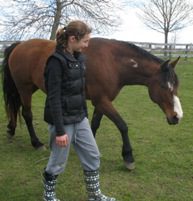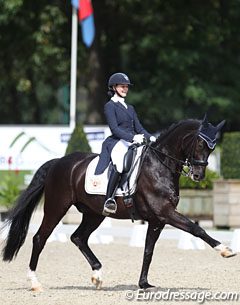
Three things a horse would like to tell you
Three things a horse would like to tell you
If you love horses and want to work and communicate with them, it’s important to learn to understand them – not just to know how to get them to do something, to find out how they think and how they learn.
There are three fundamental things that our horses would like to tell us.
1. The horse is a prey animal. You are a predator

This information is, of course, not new. The horse is a prey animal. Her biggest concern is that she might be trapped and eaten. Horses are at the forefront of their safety and the safety of the herd.
People are predators. We like to “catch” horses and control them. We often hold horses on a hard lead or we pull them by the mouth with the reins without “softening” it as often as we should. However, we can be less like a predator, act like partners. And the sagging of the lead when we lead the horse, or work based on the principle “take, take, give” instead of “take, take, take (pull, pull, pull)” are just a couple of examples that can be given.
The less often you trap a horse, the less you try to totally control it, the more often it will see you as a partner and leader of the herd. If a horse sees you as a leader or partner, he will be more likely to trust you and be cooperative with you.
When you are working with the horse, try to use signals that don’t involve too much rein/lead pressure because this is a “trap” for the horse. Try to use body language when you need to give her signals from the ground, and when you are in the saddle, the seat and leg are larger than the arm.
If your horse is frightened, remember that he is a prey animal and it is normal for him to be frightened. Try to stay relaxed and be patient. Gently ask the horse to continue doing the work you were doing before you gave him the opportunity to stop or slow down to see the horse eater. Remember that if the reaction of the horse to the “scary” object is to stop or slow down, then this is good, because the reaction could well have been a flight (spread). Do not scold the horse if he wants to stop when he is frightened. A couple of seconds will be enough, then gently bring her attention back to you and continue your workout.
2. Horses need boundaries but don’t need punishment.
Horses can become very dominant or very nervous if the person does not set clear boundaries. This means that if you simply allow the horse to do what he wants (go where he wants, push you and other people, change direction without permission, lunging, etc.), he will eventually begin to think that the person is not pays attention to her behavior, and if so, he is not a leader, next to whom it is safe, who can protect.
Horses usually react to permissiveness in two ways: they either become nervous and frightened, or they become arrogant and dominant.
But how do you set boundaries?
Protect your personal space (don’t let the horse push you or “walk over you”), don’t let the horse grab you or your clothes, and always insist on your own (for example, if you ask the horse to turn left, make sure you keep asking for a left turn until she obeys and turns around).
Just because a horse needs specific boundaries doesn’t mean it needs to be punished as well.
Horses don’t understand punishment – they don’t look like dogs or people – punishment just doesn’t work.
I’ll give you an example. The horse refuses to jump, and the rider responds with a couple of blows with a whip on its croup. The horse does not understand that the rider is punishing him for refusing to jump. Instead, the horse loses trust in the rider and tends to do one of two things:
1) tries to get rid of the horseman, because she does not like being beaten (she starts to goat or shine);
2) gets frightened and starts rushing to an obstacle, knocking down poles (like a prey animal, it runs from danger).
If the rider is constantly punishes a horse for refusals, it can become quite dangerous, deciding that jumping is not a pleasant job at all, but a constant beating. The horse will start to really smash to the barrier, try hard to get rid of the rider, goat strongly, shine, etc.
Instead, the rider must remember that the horse does not understand punishment. The rider can deal with such a situation in a completely different way. For example, if the horse refuses, the rider can give him a chance to look at the obstacle (if he is really scared), then trot (not walk, because walk means “good work, you can rest and relax”), and try to jump again once. The rider can do this as many times as necessary until the horse jumps. As soon as the horse has jumped, you can step over and stroke it at the withers and neck. This will let the horse know that he did the right thing.
If the rider handles every failure in this way, the horse will never learn to flash, buck, or charge into the obstacle. Eventually, the horse will stop refusing to jump because he will learn to trust the rider.
No matter what discipline you practice, there is always a way to correct and train a horse without resorting to punishment. Not using punishment is always safer and more effective in the long run.
3. Horses ask questions

Do you know what it looks like when your horse asks you a question? Many riders do not understand and do not know what a horse does when he wants to ask them about something.
A questioning horse is wonderful! This means that she views the person as a person who can be approached to find out the answer.
When you are standing on the ground and the horse asks you a question, he may turn his ear towards you, or look at you, or even turn his whole body towards you. While riding, the horse may slow down and/or turn its ear/ears back towards you.
When a horse asks you a question, you have the opportunity to respond with a polite, gentle signal to tell the horse what you want. This is great because it means the horse is thinking about you and what you want, not about running away from work.
Horses often ask questions when they are lunging or circling. Sometimes people do not understand that the horse is asking a question, they decide that he is simply not listening, and they drive him forward. This is how they teach the horse that the answer to everything is to run forward. If this happens all the time, the trainer will make the horse hurried or pushy.
When you are riding and the horse sometimes slows down and stops when it sees something “scary”, it asks the question of what to do next. Sometimes the rider simply pushes the horse forward. If he does this often, he can teach the horse to move faster when he is unsure or afraid of something. This is a way to train a horse to carry and goat.
When you see your horse ask you a question, let him do it and then give a gentle answer. The answer can be expressed in many actions: calmly continue moving, slow down or stop to understand that everything is not so scary.
By understanding these three things about horses, you can be a better leader for your horse. If your horse thinks you are a great leader, he will trust you and start trying. You can achieve anything while maintaining safety and comfort.
Lindsey Partridge (source); translation by Valeria Smirnova.
- Black squirrel 3 March 2018 city
An interesting article about the psychology of a horse, very useful, thanks. Answer
 Valeria Smirnova 4 March 2018 city
Valeria Smirnova 4 March 2018 cityThanks for your feedback!! Answer





